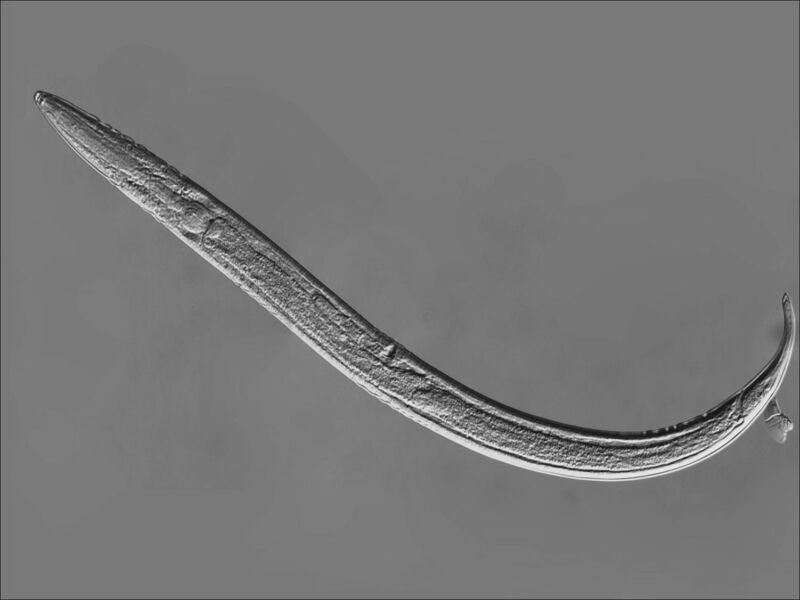
Some of the scariest monsters are microscopic. The carnivorous fungus Arthrobotrys oligospora doesn’t seem like much while it’s eating away at rotting wood. But when it senses a live worm, it will trap its victim and consume it alive—pure nightmare fuel.
Until now, not much was known about how the attack of the killer fungus happens on a molecular level. Researchers from Academia Sinica in Taiwan have finally found out how the gene activity of the fungus changes when a nematode creeps too close to A. oligospora. Led by molecular biologist Hung-Che Lin, the research team discovered that the fungus synthesizes a sort of worm adhesive and additional trapping proteins to get ahold of its meal. It then produces enzymes that break down the worm so it can start feasting.
Caught in a trap
A. oligospora lives in the soil and is mostly saprotrophic, meaning it feeds on decaying organic matter. But that can quickly change if it finds itself deprived of nutrients or senses a tempting nematode nearby. This is when it goes into carnivore mode.
Lin and his colleagues wanted to see what happened when the fungus, low on nutrients, was introduced to the nematode Caenorhabiditis elegans. The fungus showed a significant increase in DNA replication when it sensed the worm. This resulted in trap cells having additional copies of the genome. The trap cells reside in fungal filaments, or hyphae, and produce a specialized worm adhesive that would allow those hyphae to stick to the worm once it was caught in the trap.
What may be the most important genetic actions in helping the fungus to create a trap out of hyphae is ribosome biogenesis, which enables increased protein production. Ribosomes are where proteins are made, so their biogenesis (literally the creation of more ribosomes) controls cell growth and also determines how much protein is synthesized.
The researchers also identified a new group of proteins, now known as Trap Enriched Proteins (TEPs), which were the most commonly produced proteins in fungal trap cells. These seemed to contribute to trap function rather than formation.
“Given TEP protein localization to the surface of trap cells, we hypothesized that TEPs may be critical for the function of the traps,” they said in a study recently published in PLoS Biology. “Adding C. elegans… leads to their immediate capture.”
As the fungus put more effort into creating a trap and forming worm adhesive, it deprioritized activities that are not really involved in the process. Segments of DNA that usually help A. oligospora digest dead matter were down-regulated, meaning there was lower gene activity on these segments in response to the fungus sensing the worm. When a worm came close to A. oligospora, the fungus showed an up-regulation of genes that produce proteases, or enzymes that break down proteins.
Can’t get out
Additional other genes didn’t see changes in activity until the worm was already caught. Once C. elegans entered the trap that A. oligospora had set with a sticky net of hyphae, the team noticed an increase in the production of proteins that weaken prey. These proteins are able to manipulate the cells of their prey so those cells function differently, potentially providing a way for the pathogen to break in and take over. The fungus then uses proteases to digest nematodes that get stuck in its hyphae.
A. oligospora has over 400 genes that encode proteins that control its interactions with other organisms. When the introduction of a nematode made the fungus go carnivorous, more than half of these started to behave differently. These proteins weaken C. elegans through a variety of mechanisms. To give one example, some of them fight off antimicrobial peptides produced by the nematode.
The adhesive synthesized by the fungus, now thought to have a close association with TEP proteins, may have no effect on humans but is a superglue for worms that binds hyphae to their flesh. They have no way of worming their way out of being eaten alive.
This experiment might have been ghastly for the nematodes involved, but it was a breakthrough for Lin’s team. They have now identified an entire new group of genes that make a fungal trap function. Their findings with A. oligospora could be compared to the gene activity of other pathogenic fungi, including those that destroy crops, so an improved generation of antifungals might someday be influenced by this microscopic horror movie.
PLOS Biology, 2023. DOI: 10.1371/journal.pbio.3002400



3175x175(CURRENT).thumb.jpg.b05acc060982b36f5891ba728e6d953c.jpg)
Recommended Comments
There are no comments to display.
Join the conversation
You can post now and register later. If you have an account, sign in now to post with your account.
Note: Your post will require moderator approval before it will be visible.